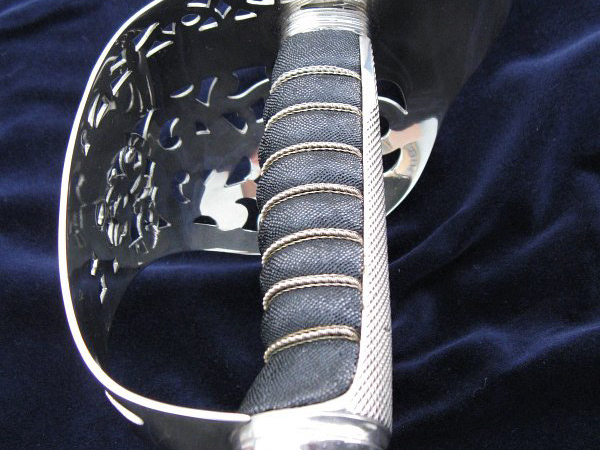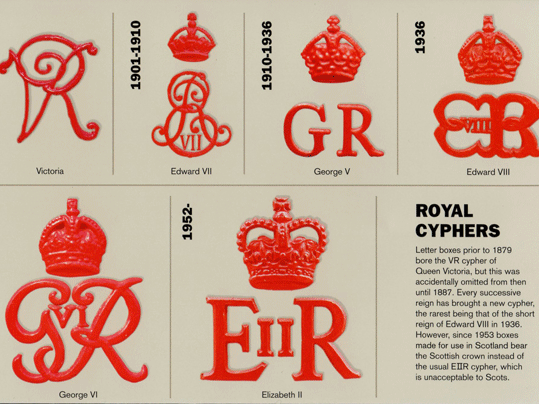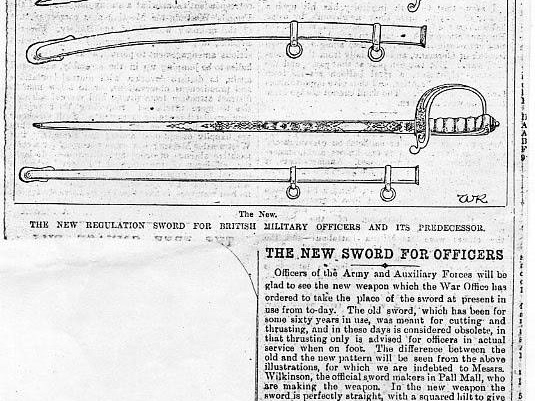Very Good British Highland Wilkinson Regiment Basket Hilted Officer's Sword
ERII post 1970. In near mint condition with traditional silver basket with red cloth lined hide basket liner, with silk tassell and ribbons, wirebound fishskin grip. Fully etched blade with Scottish devices and ERII monogramme of Her Majesty Queen Elizabeth Iind. Near mint nickel basket, nickel plated steel scabbard with small surface dimples. Eminently suitable for current service by an officer of the Scottish regiments, or just as equally as a high quality display piece, representing some of the most noble regiments in the British army, whose tradition of wearing the basket hilted broadsword [sometimes referred to as the claymore] goes back over 400 years. A finer quality service sword you will never see. The original Highland regiments were raised in the 18th century with the object of recruiting rank and file solely from the Scottish Highlands. However, due to the Highlands becoming extensively depopulated through the course of the 19th and 20th centuries, the Highland regiments of the British Army have witnessed a long-term decline in the proportion of recruits from the Highlands and have long recruited many Lowland Scots and others. The major 20th century exceptions to this rule were the First and Second World Wars, when many Highland men joined up. Around the time that the first Highland regiments were raised the Highlands had recently been a hotbed for several revolts against the establishment, namely the Jacobite Rebellions, so the loyalties of the Highlanders were often deemed suspect in the early history of the Highland regiments.
The first Highland regiment, the Black Watch was originally raised from clans openly loyal to the status quo in order for the government to better police the Highlands, which were deemed to be both rebellious and lawless by the contemporary British establishment. However, due to a pressing need for personnel in North America during the Seven Years' War, William Pitt the Elder made the decision to raise new Highland regiments to fight in this imperial war. The war ended in victory and among other things, Canada was secured as a part of the British Empire, while the British East India Company's position in India was consolidated and expanded. These Highland regiments were disbanded after the war, but other Highland regiments were raised later and, like the rest of the British Army, saw service in various wars including in the British colonisation of India and the Peninsular War.
Highland regiments played a conspicuous role in conflicts throughout the Victorian era.
By the Victorian era the loyalty of the Highlanders was no longer suspect. Queen Victoria had a personal interest in things Scottish, in particular relating to the Highlands. In addition Highland regiments had played a conspicuous role in such Victorian conflicts as the Crimean War and the putting down of the Indian Mutiny. The Highland regiments earned a reputation which influenced the mindset of those Scottish regiments which were Lowland in origin. This resulted in the wearing of tartan by Lowland regiments which had previously worn uniforms not clearly distinguishable from their Irish, Welsh and English counterparts. In the case of the Highland Light Infantry, the distinction between Highlanders and Lowlanders was slightly blurred: although classified as a non-kilted Highland regiment it was recruited from Glasgow in Lowland Scotland and bore the title of "City of Glasgow Regiment".
Scottish bagpipes have been adopted in a number of countries, largely in imitation of the pipers of Highland regiments which served throughout the former British Empire. Highland regiments were raised in a number of Commonwealth armies, often adopting formal honorary affiliations with Scottish regiments of the British Army.
ERII post 1970. In near mint condition with traditional silver basket with red cloth lined hide basket liner, with silk tassell and ribbons, wirebound fishskin grip. Fully etched blade with Scottish devices and ERII monogramme of Her Majesty Queen Elizabeth Iind. Near mint nickel basket, nickel plated steel scabbard with small surface dimples. Eminently suitable for current service by an officer of the Scottish regiments, or just as equally as a high quality display piece, representing some of the most noble regiments in the British army, whose tradition of wearing the basket hilted broadsword [sometimes referred to as the claymore] goes back over 400 years. A finer quality service sword you will never see. The original Highland regiments were raised in the 18th century with the object of recruiting rank and file solely from the Scottish Highlands. However, due to the Highlands becoming extensively depopulated through the course of the 19th and 20th centuries, the Highland regiments of the British Army have witnessed a long-term decline in the proportion of recruits from the Highlands and have long recruited many Lowland Scots and others. The major 20th century exceptions to this rule were the First and Second World Wars, when many Highland men joined up. Around the time that the first Highland regiments were raised the Highlands had recently been a hotbed for several revolts against the establishment, namely the Jacobite Rebellions, so the loyalties of the Highlanders were often deemed suspect in the early history of the Highland regiments.
The first Highland regiment, the Black Watch was originally raised from clans openly loyal to the status quo in order for the government to better police the Highlands, which were deemed to be both rebellious and lawless by the contemporary British establishment. However, due to a pressing need for personnel in North America during the Seven Years' War, William Pitt the Elder made the decision to raise new Highland regiments to fight in this imperial war. The war ended in victory and among other things, Canada was secured as a part of the British Empire, while the British East India Company's position in India was consolidated and expanded. These Highland regiments were disbanded after the war, but other Highland regiments were raised later and, like the rest of the British Army, saw service in various wars including in the British colonisation of India and the Peninsular War.
Highland regiments played a conspicuous role in conflicts throughout the Victorian era.
By the Victorian era the loyalty of the Highlanders was no longer suspect. Queen Victoria had a personal interest in things Scottish, in particular relating to the Highlands. In addition Highland regiments had played a conspicuous role in such Victorian conflicts as the Crimean War and the putting down of the Indian Mutiny. The Highland regiments earned a reputation which influenced the mindset of those Scottish regiments which were Lowland in origin. This resulted in the wearing of tartan by Lowland regiments which had previously worn uniforms not clearly distinguishable from their Irish, Welsh and English counterparts. In the case of the Highland Light Infantry, the distinction between Highlanders and Lowlanders was slightly blurred: although classified as a non-kilted Highland regiment it was recruited from Glasgow in Lowland Scotland and bore the title of "City of Glasgow Regiment".
Scottish bagpipes have been adopted in a number of countries, largely in imitation of the pipers of Highland regiments which served throughout the former British Empire. Highland regiments were raised in a number of Commonwealth armies, often adopting formal honorary affiliations with Scottish regiments of the British Army.


